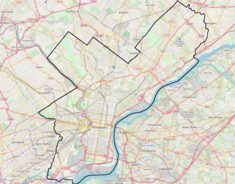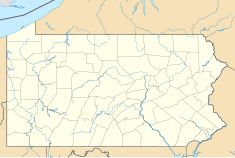
Fairmount Park is the largest municipal park in Philadelphia and the historic name for a group of parks located throughout the city. Fairmount Park consists of two park sections named East Park and West Park, divided by the Schuylkill River, with the two sections together totalling 2,052 acres (830 ha). Management of Fairmount Park and the entire citywide park system is overseen by Philadelphia Parks & Recreation, a city department created in 2010 from the merger of the Fairmount Park Commission and the Department of Recreation.

Boathouse Row is a historic site located in Philadelphia, Pennsylvania on the east bank of the Schuylkill River just north of the Fairmount Water Works and the Philadelphia Museum of Art. It consists of a row of 15 boathouses housing social and rowing clubs and their racing shells. Each of the boathouses has its own history, and all have addresses on both Boathouse Row and Kelly Drive.

The Cliffs is a historic country house located near 33rd and Oxford Streets in East Fairmount Park, Philadelphia. It is a Registered Historic Place.

Belmont Mansion is a historic mansion located in Fairmount Park in Philadelphia. Built in the early 18th century, the mansion is one of the finest examples of Palladian architecture in the United States. Since 2007, the mansion has hosted the Underground Railroad Museum.
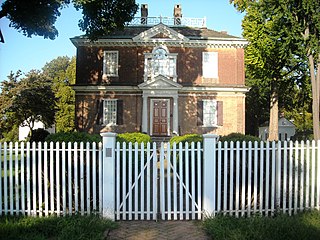
Woodford is a historic mansion at Ford Road and Greenland Drive in Fairmount Park, Philadelphia, Pennsylvania. Built about 1756, it is the first of Philadelphia's great colonial Georgian mansion houses to be built, and exemplifies the opulence of such houses. A National Historic Landmark, it now a historic house museum open to the public.

Mount Pleasant is a historic mansion in Philadelphia, Pennsylvania, atop cliffs overlooking the Schuylkill River. It was built about 1761–62 in what was then the countryside outside the city by John Macpherson and his wife Margaret. Macpherson was a privateer, or perhaps a pirate, who had had "an arm twice shot off" according to John Adams. He named the house "Clunie" after the ancient seat of his family's clan in Scotland.

Lemon Hill is a Federal-style mansion in Fairmount Park, Philadelphia, built from 1799 to 1800 by Philadelphia merchant Henry Pratt. The house is named after the citrus fruits that Pratt cultivated on the property in the early 19th century.
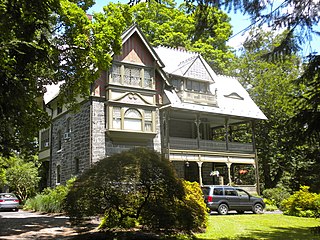
The Chestnut Hill Historic District is a historic area covering all the Chestnut Hill section of Philadelphia, Pennsylvania.

Fairmount Rowing Association is an amateur rowing club, founded in 1877. The facility, located at #2 Boathouse Row in the historic Boathouse Row of Philadelphia, Pennsylvania, is on the National Register of Historic Places. Fairmount originally catered to blue-collar youths living in the Fairmount neighborhood. In 1916, after decades of being rejected, the club was finally allowed to join the Schuylkill Navy. The Club boasts being known as the "premiere club for Masters rowing in the mid-Atlantic region" and has produced several world class rowers.
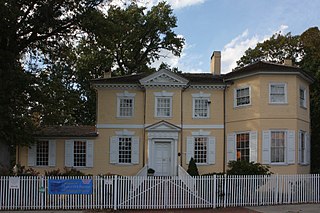
Randolph House, also known as Laurel Hill Mansion, is a historic mansion in east Fairmount Park, Philadelphia, Pennsylvania.

Chamounix is a historic home located in Fairmount Park, Philadelphia, Pennsylvania. The Federal-style house was built in 1802 by George Plumsted who was a wealthy Philadelphia merchant, then enlarged to nearly double its original size by subsequent owners after 1853. Chamounix is a 2½-story stuccoed stone dwelling measuring 45 feet long and 47 feet deep, featuring a hipped roof with dormers and a porch on three sides with decorative iron supports. The house served as a country retreat until it was appropriated by the state via eminent domain in 1869 to become a part of Fairmount Park, from which time it was used in various ways including as a boarding house, a restaurant, and a refreshment stand. After years of neglect and then fire damage, the Fairmount Park Commission decided to demolish Chamounix; however, a committee of the former American Youth Hostels successfully petitioned to save it and, since 1964, it has served as an international youth hostel.

Cedar Grove Mansion, located in west Fairmount Park, was the summer residence for five generations of Philadelphia families. The house was built as a rural retreat from city life, and was originally located within the present day Frankford neighborhood of Northeast Philadelphia, about 4 mi (6.4 km) beyond the colonial-era city limits. In 1746, Elizabeth Coates Paschall purchased the property on which the house was subsequently built. Paschall was a widow with three children who had inherited her husband's dry goods business and desired a rural retreat from the city near her father's farm in Frankford. Construction of the grey stone house on a plot of 15 acres (6.1 ha) along Frankford Road began in 1748 and continued to 1750.

The Lilacs is an early 18th-century farmhouse located in northwestern Fairmount Park, Philadelphia. The house has a large addition constructed in the early 19th century. The name was derived from the many lilac bushes on the property.

The Ohio House, or Ohio State Building, is a historic building located in west Fairmount Park, Philadelphia. The house was built from various Ohio sandstones and functioned as the Ohio state exhibit for the Centennial Exposition of 1876. The only other extant exposition structures are Memorial Hall and two small comfort stations; the building is the only extant state exhibit remaining from the exposition. The house was restored for the Bicentennial Celebration in 1976, and leased to Ohio House Partners by the Fairmount Park Historic Preservation Trust in 2006. After extensive restoration, the building was opened to the public in November 2007 and has since functioned as a cafe, event venue and offices.

Ormiston Mansion is a 2+1⁄2-story, red brick, late Georgian period house located in east Fairmount Park, Philadelphia. The house was constructed in 1798 with a large wooden porch in front and a smaller porch in the rear. Many of the original interior features remain including fireplaces with marble mantles and a Scottish bake oven. The cedar shake roof includes a widow's walk and Federal-style dormers, while six large shuttered windows are on each side of the house, and five on the front. The first floor interior includes a large drawing room spanning the entire width of the house, a kitchen, and a dining room with a large door leading to the rear porch. The back of the house overlooks the Schuylkill River.

Ridgeland Mansion is a historic two-and-a-half story, gable-roofed house located in west Fairmount Park, Philadelphia. The land was purchased by a yeoman named William Couch in 1718 and the current house was probably constructed sometime between 1752 and 1762. Originally a farm house, it was expanded to mansion proportions through various alterations and additions made by later owners, as well as by the city which had acquired the property in 1869 for the expansion of Fairmount Park. George Clymer, a Founding Father of the United States, owned the house between 1784 and 1794, though he apparently only rented it out and never lived there.

Rockland Mansion is a 2+1⁄2-story Federal-style mansion located in east Fairmount Park, Philadelphia, overlooking the Schuylkill River. The land was bought by a Philadelphia merchant named George Thomson in 1809. The mansion was completed circa 1810 using rubble stone for the masonry work which was then finished with stucco scored to resemble cut stone. Thomson used the house as a summer residence for about five years and then sold it to another merchant named Isaac Jones in 1815 whose son sold it to the city in 1870. The house and original plot of 26 acres (11 ha) of land are situated adjacent to the Mount Pleasant Mansion along Mount Pleasant Drive.

The Solitude Mansion is a historic two-and-a-half story Federal-style mansion located in west Fairmount Park, Philadelphia, above the banks of the Schuylkill River on the grounds of the Philadelphia Zoo. The house was built sometime between 1784 and 1785, and historical records suggest that it was designed by its owner John Penn, grandson of William Penn, the founder of the city of Philadelphia and the state of Pennsylvania. The mansion is also referred to as The Solitude and The Solitude House, as well as the John Penn House and simply Solitude without the definite article. The name of the house was inspired by the Duke of Württemberg's much larger Castle Solitude outside Stuttgart, Germany. The Solitude is the only extant home of a Penn family member in the United States.

